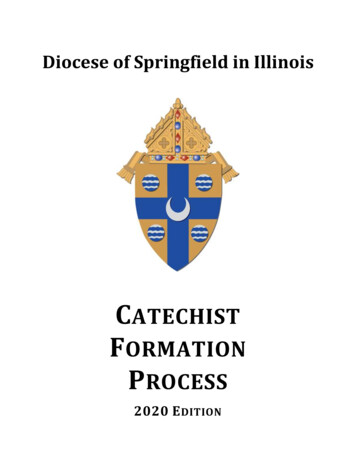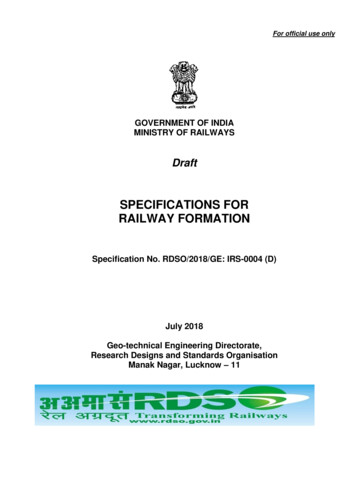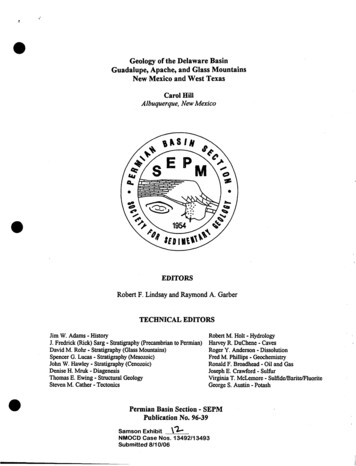
Transcription
STRATEGY AND THE STRATEGY FORMATION PROCESSArnoldo C. HaxNicolas S. MajlufSloan School of ManagementM.I.T.August 1986WP # 1810-86
STRATEGY AND THE STRATEGY FORMATION PROCESSArnoldo C. HaxNicolas S. MajlufAbstractIn this paper an effort is made to bring new insights into the complexfield of strategy by defining the concept of strategy and the process ofstrategy formation.The concept of strategy is an abstraction with normativequalities that has been obtained by reviewing and integrating the definitionsof strategy offered by leading scholars in the field.The process ofstrategy formation adopts a wide variety of forms in different organizations,and it should be managed consistently with the overall strategic objectivesof the firm, its management style, and its organizational culture.Dimensionsto profile both the concept of strategy and the strategy formation processare identified to help diagnose the quality of strategic thinking in a firm.
-2-IntroductionWhat is strategy?Is it an elusive subject, full of controversy,lacking a strong disciplinary support that evades any possible attempt toformally define it?We do not believe so.In this paper we intend tosuggest a definition of strategy which serves to unify previous work inthis field, as well as presenting a normative model of some desirable attributes a good strategy should possess.Moreover, we will address the complex-ities inherent in the process of strategy formation, comment on the diversitiesof content and style, and propose a diagnostic mechanism which would allowpracticing managers to generate a profile for the strategy formation processin their firms.The Various Dimensions in the Concept of StrategyThe different authors who have provided definitions on the concept ofstrategy have tended to give selective attention to the wide variety of issuesrelevant to strategy definition.By reviewing some of the most important worksin the field of strategy, we attempt to identify and characterize the criticaldimensions of the concept of strategy.1.,Strategy as a means of establishing the organizational purpose, in termsof its long-term objectives, action programs, and resource allocationpriorities.This intent of strategy emanates quite explicitly from the definitiongiven by Chandler (1962):"Strategy is the determination of the basic long-term goalsof an enterprise, and the adoption of courses of actionsand the allocation of resources necessary to carry out thesegoals."E
-3-The same message is extracted from Schendel and Hatten's definition(1972):"Strategy is the basic goals and objectives of the organization,the major programs of action chosen to reach these goals andobjectives, and the major pattern of resource allocation usedto relate the organization to its environment."2.Strategy as definition of the competitive domain of the firm.It has been long recognized that one of the central concerns of strategyhas to do with defining the businesses the firm is in or is to be in.Thisdimension of strategy is properly captured in one of the earlier and mostinfluential books in this field written by Learned, Christensen, Andrews andGuth (1965):"Strategy is the pattern of objectives, purposes or goals andmajor policies and plans for achieving these goals, stated insuch a way as to define what businesses the company is in oris to be in and the kind of company it is or is to be."3.Strategy as a coherent, unifying, and integrative blueprint of theorganization as a whole.This notion is advanced by Glueck (1976):"Strategy is a unified, comprehensive, and integrative plandesigned to assure that the basic objectives of the enterpriseare achieved."4.Strategy as a response to external opportunities and threats, andinternal strengths and weaknesses.According to this perspective, strategy is principally viewed asresponding to external and internal forces which impact the organization.Argyris (1985) reflects this point of view in his definition of strategy:"Strategy formulation and implementation include identifyingopportunities and threats in the organization's environment,evaluating the strengths and weaknesses of the organization,
-4-designing structures, defining roles, hiring appropriate people,and developing appropriate rewards to keep those people motivatedto make contributions."Similarly, Steiner and Meiner (1977) state:"Strategy is the forging of company missions, setting objectivesfor the organization in light of external and internal forces,formulating specific policies and strategies to achieve objectives,and ensuring their proper implementation so that the basicpurposes and objectives of the organization will be achieved."There are some authors who tend to emphasize more strongly the need fororganizations to obtain a viable match with its environment.In this case,the central role of strategy is not only viewed as passively responding tothe opportunities and threats presented by the external environment, but alsoas continuously and actively adapting the organization to meet the demandsof a changing environment.A principal proponent of this view has beenMintzberg (1979):"Strategy is a mediating force between the organization and itsenvironment: consistent patterns of streams of organizationaldecisions to deal with the environment."5.Strategy as a central vehicle for achieving competitive advantage.Michael Porter has been the champion of making explicit the quest forcompetitive advantage as the central thrust in strategy.In his first book(Porter, 1980), he defines a framework to assess the sttractiveness of anindustry, and discusses generic strategies for an effective positioning ofa firm within that industry.In his second book (Porter, 1985), he definescompetitive strategy as:"The search for a favorable competitive position in anindustry, the fundamental arena in which competition occurs.Competitive strategy aims to establish a profitable and sustainable position against the forces that determine industrycompetition."In this latter book, he uses the value chain as a powerful conceptualtool to direct the firm activities toward enhancing its competitive position.j l IIII
-5-6. Strategy as a motivating force for the stakeholders.The notion of stakeholders has gained in importance as an element ofstrategic concern in the past years.Stakeholders include everybody whodirectly or indirectly receive the benefits or costs derived from the actionsof the firm; they are: shareholders, employees, managers, customers, suppliers,debtholders, communities, government, etc.Andrews (1980), in a very popular definition, not only reinforces thenotion of strategy as a determinant of organizational purpose, but explicitlyincorporates the importance of stakeholders when stating:"Corporate strategy is the pattern of decisions in a companythat determines and reveals its objectives, purposes, or goals,produces the principal policies and plans for achieving thosegoals, and defines the range of businesses the company is topursue, the kind of economic and human organization it is orintends to be, and the nature of the economic and noneconomiccontribution it intends to make to its shareholders, employees,customers, and communities."Andrews also makes a clear distinction between the notion of strategywhen defined as corporate and business levels:"Corporate strategy defines the businesses in which a companywill compete, preferably in a way that focuses resources toconvert distinctive competence into competitive advantage.""Business strategy is the determination of how a company willcompete in a given business, and position itself among itscompetitors."An even further emphasis on the importance of stakeholders in thedefinition of strategy is being given by what Chaffee (1985) calls theinterpretive model:"Strategy is defined as orienting 'metaphases' or framesof reference that allow the organization and its environmentto be understood by organizational stakeholders. On thisbasis, stakeholders are motivated to believe and to act inways that are expected to produce favorable results for theorganization."This definition of strategy emphasizes the need to establish socialcontracts, perceived as a collection of cooperative agreements entered into-. -- ------.
-6-by individuals with free will, which will produce a process of social interchange in which perceptions will be affirmed, modified or replaced.Strategy is then the basic thrust that will enhance cooperative behaviorcontributing toward the organizational well-being.Towards a Unified Concept of StrategyThe previous observations allow us to perceive strategy as a multidimensional concept that embraces all the critical activities of the firm,providing it with a sense of unity, direction, and purpose, as well asfacilitating the necessary changes induced by its environment.We do notsee any necessary contradictions in the various definitions which havebeen presented.In fact, it is an easy matter to combine all of them intoa single more comprehensive definition of strategy.Strategy is:a coherent, unifying, and integrative pattern of decision,* that determines and reveals the organizational purpose in terms of longterm objectives, action programs, and resource allocation priorities,* selects the businesses the organization is in or is to be in,* defines the kind of economic and human organization the company is orintends to be,* attempting to achieve a long term sustainable advantage in each of itsbusinesses, by properly responding to the opportunities and threats inthe firm's environment, and the strengths and weaknesses of the organization,* engaging all the hierarchical levels of the firm - corporate, business,functional * and defining the nature of the economic and non-economic contributions itintends to make to its stakeholders.
-7-From this unifying point of view, strategy becomes a fundamental framework for an organization to assert its vital continuity, while, at the sametime, forcefully facilitating its adaptation to a changing environment.The essence of strategy thus becomes the purposeful management of changetoward the achievement of competitive advantage in every business the firmis engaged.Finally, there is a formal recognition that the recipients ofthe firm's actions are the wide constituency of its stakeholders.Therefore,the ultimate objective of strategy should address stakeholders' benefits,providing a base for establishing the host of transactions and socialcontracts linking the firm to its stakeholders.The Strategy Formation ProcessStrategy, separated from strategy making, is academic at best.It isimpossible to comprehend the difficulties associated with the formulation andimplementation of strategy if one ignores the inseparability that existsbetween the concept of strategy and the process of making it a reality ina partiuclar organizational setting.In fact, the process school ofresearch, as defined by Bower and Boz (1979), views strategy as the outcomeof three different processes contributing to strategy formation:"1. The cognitive processes of individuals onwhich understandings of the environment of strategy are based;social and organizational processes by whichThe2.perceptions are channelled and commitments developed;and3. The political processes by which the power to influencepurpose and resources is shifted."They go even further when asserting that "the task of the chief executiveis viewed as the administration of these processes," which require thedevelopment of a broad vision of what to achieve and the management of anetwork of organizational forces that lead to the discovery, evolution and
-8-enrichment of that vision.We discuss now some issues which we consider the most relevant to gaina deeper understanding of the concepts of strategy and the strategy formationprocess.1.Problems in making strategy explicit.Perhaps the greatest controversy surrounding the issues of strategymaking centers on how explicitly strategy should be communicated both internallyin the organization and to relevant external constituencies.Edward Wrapp,as quoted by Andrews (1981), suggests that there are four strata for thedefinition of corporate strategy:"Stratum I - corporate strategy for the annual report. Usuallythis version is sterilized by top management and edited by thepublic relations staff. For the shareholders, it conveys asense of direction, an assurance that management knows where itis trying to take the company."Stratum II - corporate strategy for the board of directors,Somehwat morecomprehensive and revealing than Stratum I, most boards ofdirectors must settle for this level of enlightenment, particularly in the larger, multibusiness companies.financial analysts, and middle management."Here we get glimpses of the segments of the company and perhapsgood hints as to where management sees the growth opportunities.As top management discusses Stratum II with the intendedaudiences, the game plan usually calls for keeping it simpleand camouflaging the deeper potholes."Stratum III - corporate strategy for top management.In anorganization of any size or complexity, several members of topmanagement can be expected to participate in discussions approaching a full consideration of moves and countermoves, the strengthof the competition, the competence of operating management, andperhaps a hot topic such as odds for survival of the currentmanagement. Needing the support of this group, the CEO willusually try to reach agreement in these discussions."Stratum IV - the CEO's private corporate strategy. If the CEOis a strategic thinker, he is seldom inhibited by anyone - notby his top managers, not by his directors, not by his professionalplanners, and not by his outside advisers. He may be mulling arange of moves that he discloses to almost no one. In tryingto gain a deeper comprehension of who exerts the most influence
-9-with a CEO and why, I have discovered that even when he shareshis innermost thoughts with one or two managers or directors oradvisers, his strength of will and conviction dominate thediscussions."The reasons for reticence are usually a complex tangle. Partsof the private strategy may be dictated by the CEO's selfinterest; or he may be analyzing developments that those aroundhim are not yet ready to recongize and diagnose; or he may notbe willing to share knowledge of delicate maneuvers for fearof premature disclosure; or, as is often the case, he maybelieve he is the best qualified to sort out the pros and consand decide how to proceed."There are many lessons which can be extracted from these four levelsof strategy distinguished by Wrapp:First, the enormity of the influence that the CEO has both in shapingthe strategy of the firm and communicating it;Second, the degree of openness and detail at which strategy is communicated would vary significantly depending on the CEO style of management;Third, the level of participation in strategy formation would alsochange quite drastically from company to company; andFourth, the CEO has the ability to manage the strategy formation process,in order to build up the kind of consensus necessary for effective strategymaking.2.Fornal-analytical process vs. power-behavioral approaches.There are two very different perspectives with regard to the need toformalize the process of strategy formation.One one extreme, there are thosewho expouse the view of integrated decision-making process relying heavilyon analytical tools and methodologies to help managers, at all hierarchicallevels, to reach a better quality of strategic thinking.Strategy formationis regarded as a formal and disciplined process leading to a well-definedorganizational-wide effort aimed at the complete specification of corporate,business, and functional strategy.Those favoring this approach tend to
-10-advocate the use of formal planning systems, management control and consistentreward mechanisms to increase the quality of strategic decision-making(Ansoff 1984, Hax and Majluf, 1984a, 1984b, Lorange 1980, Porter, 1980, 1985,Yavitz and Newman, 1982).On the other extreme, there is a second school of management which restson the behavioral theory of the firm and espouses a power-behavioral approachto strategy formation.This school emphasizes issues such as multiple goalstructures of organizations, the policy of strategic decisions, executivebargaining and negotiation processes, the role of coalitions in strategicmanagement, and the practice of "muddling through" (Cyert and March 1963,Lindbloom 1959, Simon 1976, Wrapp 1967).These two schools of thought have made significant contributions inincreasing our understanding of the central strategic issues.However, neitherthe formal-system planning, nor the power-behavioral paradigms adequatelycharacterize the way successful strategy-formation processes operate.Thesetaxonomies have been useful in providing more focused thrust to academicresearch work but neither approach serves as a normative or descriptive model.To get the best out of strategy making, there should be a proper blendingof the power of formal analytic thinking within a context that recognizesthe enormous relevance of the behavioral aspects of management.Quinn (1980),who has undertaken extensive field research on eactual strategic changeprocesses in major corporations, asserts that:"Effective executives artfully blend formal analysis, behavioraltechniques, and power politics to bring cohesive step-by-stepmovements toward ends which initially are broadly conceived,but which are then constantly refined and reshaped as newinformation appears."This integrative methodology is described by Quinn as "logicalincrementalism."
-11-3. Strategy as a pattern of actions as opposed to forward-looking plan.Another element of controversy in strategy making is the relevant timeimplications of strategy.There are some authors who tend to view strategyexclusively shaping the future direction of the firm; thus, the strategy ofthe firm becomes the collection of objectives and action programs orientedat managing the future change of the organization.This view of strategy ispatently clear in the definition provided by Newman and Logan (1971):"Strategies are forward-looking plans that anticipate changeand initiate actions to take advantage of opportunities thatare integrated into the concept or mission of the company."Alternatively, strategy is also viewed as a pattern of actions emergingfrom the past decisions the firm has undertaken.school of thought is Mintzberg.A leading proponent of thisMintzberg and Water (1985) define strategyas "a pattern in a stream of decisions."The authors claim that:"This definition was developed to operationalize the conceptof strategy, namely to provide a tangible basis on which toconduct research into how it forms in organizations. Streamsof behavior could be isolated and strategies identified aspatterns or consistencies in such streams. The origins of thesestrategies could then be investigated, with particular attentionpaid to exploring the relationship bewteen leadership plans andintentions, and what the organization actually did."Wrapp (1984), reinforcing this notion of strategy as emerging from apattern of decisions, uses the following simple diagram to make a veryimportant point.General ManagerOperating ProblemsOperating DecisionsCorporate Strategy-Planners
-12-"The illustration is of a general manager involved in operatingproblems and therefore in a position to influence operatingdecisions. Over time, a corporate strategy, apparent to theorganization, evolves from the patterns discernable in operatingdecisions. At this point, the general manager insists that thosewho are making current operating decisions insure that they areconsistent with the corporate strategy."This represents one of the central issues of strategy making.Literally,thousands of decisions are being made every day in large and complex organizations.The only way to make them consistent is to establish some sense ofpermanent strategic direction that provides a rich framework within whichthose decisions can be made.Nonetheless, interpretting too rigidly the definition of strategy asa pattern in a stream of decisions revealed from the past, might lead to aninability to shape new directions for the firm.In a strict sense, strategycould only become known and explicit ex-post, when, from an historicalperspective, it would be possible to decipher it from the continuum of pastevents.From the point of view of a practicing manager, this concept ofstrategy is clearly unacceptable.Indeed, strategy is a most importantvehicle to deal with intended change.Strategy should be cognizant of thepast heritage of the firm, but at the same time, forward looking.Consequently, strategy making becomes a delicate balance between learning from the past and shaping up new courses of action that will lead theorganization toward a future state which might include a substantial departurefrom its past conduct.4.Deliberate vs. emergent strategy as basis for a typology of strategyformation.In the already cited work of Mintzberg and Waters (1985), besidesdefining strategy as a pattern in a stream of decisions, the authors inroducethe concepts of deliberate and emergent strategies.Comparing intended
-13-strategy with realized strategy, allows the recognition of deliberate strategy- which are realized as intended - and emergent strategy - patterns orconsistencies realized despite or in the absence of intentions.These two concepts, especially their interplay, have become the basisfor the proposal of a typology to characterize various kinds of strategyformation processes.At one end of this continuum falls the purely deliberatestrategy, with the purely emergent at the other end.Between these twoextremes fall strategies which would combine various states of the dimensionswe have discussed before: the degree of explicitness, openess, participativeness, centralized involvement, consensus management, formalization vs. powerbehavior drives, and continuity vs. future change.Also, the type of strategywill be affected by the nature of the enviornment the firm is dealing with,particularly whether it is more or less benign, controllable, and predictable.Figure 1 provides a summary description of the types of strategy formationproposed by Mintzberg and Waters.The key conclusion to be extracted from this typology is that strategyformation has two critical forces acting simultaneously: one is deliberate,the other is emergent.Deliberate strategy is required because managersneed to provide a sense of purposeful direction to the organization.Emergentstrategy implies "learning what works - taking one action at a time insearch for that viable pattern or consistency.chaos, but unintended order."Emergent strategy means noEmergent strategy does not have to mean thatmanagement is out of control, only that it is open, flexible, and responsive;in other words, willing to learn.ConclusionPart of the confusion surrounding the issue of strategy can be elucidated
-14-Figure 1:Strategy-PlannedA Typology of Strategy Formation ProcessesMajor FeaturesStrategies originate in formal plans: precise intentionsexist, formulated and articulated by central leadership,backed up by formal controls to ensure surprise-free implementation in benign, controllable or predictable environment;strategies most deliberate.Entrepreneurial Strategies originate in central vision: intentions exist aspersonal, unarticulated vision of single leader, and so adaptable to new opportunities; organization under personal controlof leader and located in protected niche in environment;strategies relatively deliberate but can emerge.IdeologicalStrategies originate in shared beliefs: intentions exist ascollective vision of all actors, in inspirational form andrelatively immutable, controlled normatively throughindoctrination and/or socialization; organization oftenproactive vis-a-vis environment; strategies rather deliberate.UmbrellaStrategies originate in constraints: leadership, in partialcontrol of organizational actions, defines strategicboundaries or targets within which other actors responds toown forces or to complex, perhaps also unpredictable environment; strategies partly deliberate, partly emergent anddeliberately emergent.ProcessStrategies originate in process: leadership controls processaspects of strategy (hiring, structure, etc.), leavingcontent aspects to other actors; strategies partly deliberate,partly emergent (and, again, deliberately emergent).UnconnectedStrategies originate in enclaves: actor(s) loosely coupledto rest of organization produce(s) patterns in own actionsin absence of, or in direct contradiction to, central orcommon intentions; strategies organizationally emergent whetheror not deliberate for actor(s).ConsensusStrategies originate in consensus: through mutual adjustment,actors converge on patterns that become pervasive in absenceof central or common intentions; strategies rather emergent.ImposedStrategies originate in environment: environment dictatespatterns in actions either through direct imposition orthrough implicitly pre-empting or bounding organizationalchoice; strategies most emergent, although may be internalizedby organization and made deliberate.
-15-by intellectually separating the concept of strategy from the process ofstrategy formation.As we attempted to demonstrate in the first half ofthis paper, it is easy to blend the different dimensions of the concept ofstrategy into a single unifying definition that might provide a basis forreconciling these various points of view expressed by leading authors in thefield.The issue is more complex when bringing in the question of strategyformation.Now we face an enormous plurality of different ways to reach theideals imbedded in the concept of strategy.to anybody.But that should not be surprisingThis is simply the manifestation of the enormous variety which ispresent in any social organization.We can say what strategy is, but wecannot propose a universal formula applicable to any conceivable firm facingany kind of environment that would have a general validity.However, this lack of a universal recipe for the development of asuccessful strategy should not be viewed as implying that any strategy or anyprocess to reach it can be equally effective.There are certain attributesof the concept of strategy that the firm should adhere to.Figure 2 givesa simple chart that can be used to obtain a profile of the concept ofstrategy in a firm.It is our opinion that the attributes listed in thatfigures can be interpreted in a normative sense, by defining a profileskewed to the left as closer to an idealized model of strategy.Quite a different picture is obtained when addressing the issue of thestrategy formation process.profiling of that process.accepted.Figure 3 provides a chart to facilitate theHow, there is no normative paradigm which isThe important requirement of the process is that it should bemanaged consistently in accordance with the overall strategic objectives ofthe firm, its management style, and its organizational culture.Moreover,the strategy formation process should be integrated with the remaining
-16 - U.LUZDz,n c( a(w0J(nZ--d,LU0LUILU uI-iC4--jozULL4iI0a)o,aMC. w0ZzL o0ULUJLJLlU9 LUZz .cn/U,C',LUIO c0:LUII-OZUOZZWa-nLuULLICD U, ZUjw- w. zCOZ"'a. ll-1 1111. -u,n--Z :-L -U,mwU n0u,coZI:LLz(.OZLLU1-00ZZIZOc-ZI0a-U,OU-. ZzLUX-zzOn"UZ0zZu,*oU1zZZ,0zZLU(.0C, Zcnx LLm,o-:w L 0CWI-ZzCwU!!-a-aZ-Zr: 'WUI ocn,(x zCUZUhiI. u,U-0-1ZC,(cnI-n-WOnU,1-Z- LUZnN-Z-are46OrcnI.--Z -J,W0-a)-4 LUIZz0I-0 o00w- X-LUI-ZIcnui(0U4r)COxLza)4-iU,(onU,ZLULUw-I-jcxL- -Z -Lwo. a'zmzU-oo9-zw r-LuIcnLLJ
-17--W-rrzD u,I- - I--r,.CDowZcDW UuwwU.atYDHCw:C3CDH-0:Co-L. o, OwC:IUi-o--J(.L;41v,Z OzI,-w.o.QLLZ(0uoOwoE.Ce uI,coaLw, Z04)U0UZZ-WOUcZ -U4J04iC)a- UZ,,-J-,XZ,c cn o(0 LZ44UW·u H( I , /z a. c -F-0LUJI-- XZCJ I -H l 0w-w.U-aL---oCJO uULLL.zC-C,Za0Cz,, LUUOUOLU -.LwILCzC,,. COnLUcn . amLUJC,,F U-L LLL)- 0 C', ( 0aUI O-- O zH--(i, HLaW OLIH u,H UaC'3I.-nc)(.Uo,,UOH0 .t L L H-- ,'LLIZ:C SC 0-UulC,WZHO--H-Z--O Ua I- CGH0 :C,-- .cn ,cC-:c Lz C2-4-Z LLI(D-CZ-ocnCL0oCCOLUzsLU.-.LU,,LU 0z0ZLU, .,*0)1-4,LUOcU0(zZoUzLu. C F-ZJI ZZ.13--LJI--CC,LLI'J C UW--r C,,Uo---La0 JLLLLIty, ) .- ,L- .LLHCNJ---m . . -( -.- I .-- - 7·- ----------
-18-administrative processes of the firm; most notably, management control,information and reward systems, as well as the organizational structure.The realization of the careful integration among managerial processes,structure and culture is what leads toward effective strategic management,a subject that we have discussed elsewhere (Hax and Majluf, 1984a, Chapter 5).There is a great degree of subjectivity in this profiling of theconcept of strategy and the strategic planning process.When differentindividuals and groups in a firm try to assess the characteristics ofstrategic thinking in the organization, their varying perceptions on thisissue can be positively used to transform the strategy formation process ina way that will help to achieve the ideal of strategy as a unifying patternfor the firm.
-19-ReferencesAndrews, Kenneth R., The Concept of Corporate Strategy, Richard D. Irwin,Homewood, IL, 1980.Andrews, Kenneth R., "Corporate Strategy as a Vital Function of the Board,"Harvard Business Review, Vol. 59, No. 6, November-December 1981,pp. 174-184.Ansoff, H. Igor, Implanting Strategic Management, Prentice Hall, EnglewoodCliffs, NJ1984.Argyris, Chris, Strategy Change and Defensive Routines, Pitman PublishingInc., Martshfield, MA, 1985.Bower, Joseph L., and Yves Doz, "Strategy Fromulation: A Social and PoliticalProcess," in C. W. Hofer and Dan Schendel (eds.), Strategic Management:A New View of Business Policy and Planning, Little Brown and Co., Boston,MA, 1979.Chaffee, Ellen E., "Three Models of Strategy," Academy of Management Review,Vol. 10
strategy formation. The concept of strategy is an abstraction with normative qualities that has been obtained by reviewing and integrating the definitions of strategy offered by leading scholars in the field. The










